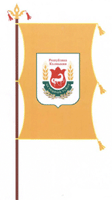This article needs additional citations for verification .(December 2025) |
 | |
| Proportion | 1:2 |
|---|---|
| Adopted | 30 July 1993 |
| Design | Yellow background with a sky blue circle in the center containing a white lotus |
| Designed by | Bata Badmayevich Erdneyev |
 Flag of Kalmykia (1992–1993) | |
| Proportion | 1:2 |
| Adopted | 30 October 1992 |
| Designed by | P. Bitkeyev |
 Flag of the Kalmyk ASSR | |
| Proportion | 1:2 |
| Adopted | 29 July 1958 |
| Design | Variant of the Russian SFSR flag with "Kalmyk ASSR" written in Russian and Kalmyk below the hammer and sickle. |
The flag of Kalmykia [a] consists of a yellow background with a sky blue circle in the center containing a white lotus. The yellow symbolizes both the sun and the Tibetan Buddhist faith of the Kalmyk people. The blue symbolizes the eternal blue sky and steadiness. The lotus symbolizes both purity, spiritual rebirth and happiness. Its five upper petals symbolize the continents and the lower four petals symbolize for the quarters of the globe. Together, they symbolize the will of the Kalmyks to live in friendship and to cooperate with all the nations of the world.
Contents
The current flag of Kalmykia also has some similarities with the flags of Kazakhstan and Palau since 30 July 1993.
The first post soviet flag of Kalmykia (1992–1993) was adopted by law of 30 October 1992. (Source: Government of the Republic of Kalmykia)
Article 158: The National flag of the Republic of Kalmykia — Khalmg Tangch is a rectangular panel consisting of three horizontal stripes: the upper one is sky-blue, the middle one is golden-yellow and the lower one is scarlet. In the centre of the golden-yellow stripe, in a circle having a diameter equal to 1/4 of the flag width, is a sign in the form of flame of fire over the two wavy lines. The sign and the circumference are scarlet. The ratio of the width of the stripes of light blue and scarlet to the width of the golden-yellow stripe is 1:2. The ratio of the flag width to its length is 1:2.











